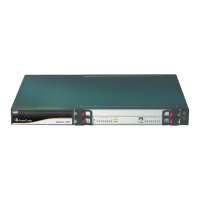User's Manual 566 Document #: LTRT-89730
Mediant 3000
28.5.7 SRTP-RTP and SRTP-SRTP Transcoding
The device supports transcoding between SRTP and RTP. The device can also enforce
specific SBC legs to use SRTP and/or RTP. The device’s handling of SRTP/RTP is
configured using the IP Profile parameter, SBCMediaSecurityBehaviour, which provides
the following options:
SBC passes the media as is, regardless of whether it’s RTP or SRTP (default).
SBC legs negotiate only SRTP media lines (m=); RTP media lines are removed from
the incoming SDP offer-answer.
SBC legs negotiate only RTP media lines; SRTP media lines are removed from the
incoming offer-answer.
Each SDP offer-answer is extended (if not already) to two media lines for RTP and
SRTP.
If after SDP offer-answer negotiation, one SBC leg uses RTP while the other uses SRTP,
the device performs RTP-SRTP transcoding. To translate between RTP and SRTP, the
following prerequisites must be met:
At least one supported SDP "crypto" attribute.
The EnableMediaSecurity parameter must be set to 1.
Transcoding where both legs are configured for SRTP is typically required to trans-encrypt
and trans-decrypt. This is relevant when the MKI and Symmetric MKI parameters are
enabled. In other words, both sides need to both encrypt and decrypt the outgoing and
incoming SRTP packets, respectively.
DSP resources are not required for RTP-SRTP transcoding.
28.5.8 Multiple RTP Media Streams per Call Session
The device's SBC application supports multiple RTP media streams per SBC call session.
Up to five different media types can be included in a session:
Audio (m=audio)
Video (m=video)
Text (m=text)
Fax (m=image)
Therefore, the device supports transcoding of various attributes in the SDP offer-answer
(e.g., codec, port, and packetization time) per media type. If the device is unable to perform
transcoding (e.g., does not support the coder), it relays the SBC dialog transparently.
28.5.9 Interworking Miscellaneous Media Handling
This section describes various interworking features relating to media handling.
28.5.9.1 Interworking DTMF Methods
The device supports interworking between various DTMF methods such as RFC 2833, In-
Band DTMF’s, and SIP INFO (Cisco\Nortel\Korea). By default, the device allows the
remote user agents to negotiate (in case of RFC 2833) and passes DTMF without
intervention. However, if two user agents (UA) support different DTMF methods, the device
can interwork these different DTMF methods at each leg.

